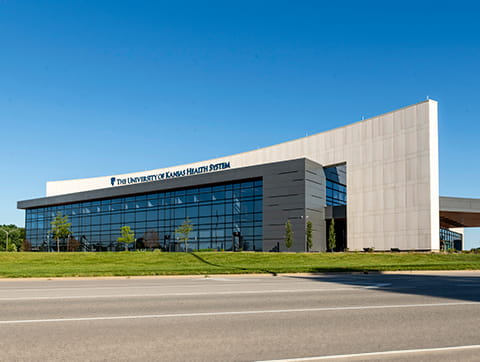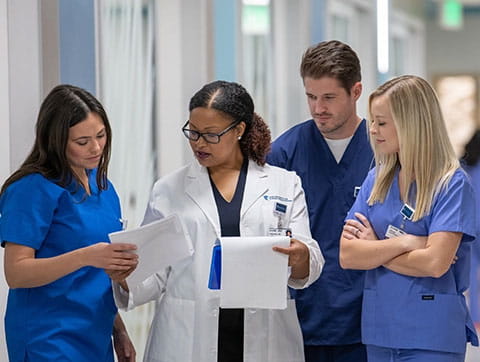For patients who have been hospitalized 2-3 times in a 12-month period for heart failure, poorer outcomes are more likely. Left ventricular assist devices (LVADs) can help keep this population alive and improve quality of life. Internationally, and in our program, the 1-year survival rate is greater than 80%.
Offering LVADs and other mechanical circulatory support devices is an essential part of comprehensive care as The University of Kansas Health System enhances its advanced heart failure and transplant services. It also gives patients in the region a second opinion close by. Having more than 1 local institution with this capability increases overall visibility and challenges each hospital to maintain and improve quality and outcomes.
We have built a team of professionals who have experience with LVADs as part of established, high-volume institutions. This experience, combined with surgical skill, an excellent nursing team and dedicated palliative care experts, has enabled us to get patients back on their feet and living successfully. Our length of stay averages about 18 days, much better than the 2022 national average of 26 days.
HeartMate 3™ device
We implant the HeartMate 3™ device. We also provide care for patients who have previously implanted HeartMate II® and HeartWare HVAD® LVAD devices.
The HeartMate 3™ is a surgically implanted, full MagLev™ flow technology system that works in parallel with the native ventricle. It's powered electrically through a percutaneous driveline. The HeartMate 3 was developed with the goal of providing several years of circulatory support for a broad range of advanced heart failure patients – as a destination therapy or bridge to transplant.
For some patients, the HeartMate 3 is implanted less invasively through a small thoracotomy and another small incision, avoiding a full open-sternum surgery. This can shorten the length of hospital stay for the patient and decrease blood loss and right ventricular dysfunction, allowing the patient to return to daily life sooner.
The HeartMate 3 is durable, safe and able to get patients out of heart failure so they can enjoy life. The latest advancement in ventricular assist device therapy, the HeartMate 3 has been shown to reverse the symptoms of heart failure, improve long-term survival and help people have a better quality of life. This advanced technology has also greatly reduced stroke rates and pump thrombosis event rates.
Quality of life enhanced
Some patients fear an assist device will negatively affect their quality of life. To the contrary, our experience and data prove that patients have an objective increase in quality of life when they come out of heart failure supported by a device. Most can do 90% of what they could prior to receiving the device – sometimes even more.
Additionally, we can do these procedures less invasively than ever before. We are experiencing so many advances that medical assist devices may one day rival transplant for longevity and outcomes.
Transplant outcomes improved
Another common fear is the device will negatively affect the outcome of a future transplant. Our experience shows that some patients who receive a VAD prior to transplant see their heart failure symptoms abate, along with improvement in kidney, liver and respiratory function. They go into the transplant stronger and have better outcomes.
Earlier evaluation for greater opportunities
We encourage referring physicians to consult us earlier rather than later as they manage patients' heart failure. We can work with you to complete a full heart failure evaluation. Our methodical evaluation process and access to a variety of therapies can help identify the next steps.
Coordinated care is a priority
We work to make the evaluation, surgery and follow-up care as stress-free as possible for patients and referring providers. We work to maintain a constant stream of communication with providers through our nurse navigators and coordinators. We are happy to provide reports as frequently as desired and to co-manage the complex VAD care as much as possible – especially for patients who live a distance from the hospital. A VAD clinician is available 24/7 to address any concerns.
When to refer
Patients with the following should be referred for evaluation for advanced heart failure therapies, including LVAD:
- New York Heart Association (NYHA) Class IIIB or IV heart failure
- Any one of the following high-risk clinical triggers:
I IV Inotropes
N NYHA IIIB/IV or persistently elevated natriuretic peptides
E End-organ dysfunction (Cr>1.8mg/dL or BUN. 43mg/dL)
E Ejection fraction ≤35%
D Defibrillator shocks
H Hospitalizations >1
E Edema (or elevated PA pressure) despite escalating diuretics
L Low blood pressure, high heart rate
P Prognostic medication – progressive intolerance or down-titration GDMT
When deciding if a patient is a good LVAD candidate, we operate within a wide spectrum of parameters. For example, there's no specific ejection fraction cutoff for qualifying. Patients with a history of cancer, nicotine addiction, substance abuse or lack of insurance may not be a candidate for heart transplant. These situations, however, are not an absolute contraindication for LVAD eligibility. We prefer to consult with physicians early, so we can work together with the patient to consider options.




